151 Quick Ideas for Delegating and Decision Making
Robert E. Dittmer and
Stephanie McFarland

Copyright 2007 by Robert E. Dittmer and Stephanie McFarland
All rights reserved under the Pan-American and International Copyright Conventions. This book may not be reproduced, in whole or in part, in any form or by any means electronic or mechanical, including photocopying, recording, or by any information storage and retrieval system now known or hereafter invented, without written permission from the publisher, The Career Press.
151 QUICK IDEAS FOR DELEGATING AND DECISION MAKING
EDITED BY DIANNA WALSH
TYPESET BY GINA TALUCCI
Cover design by Jeff Piasky
Printed in the U.S.A. by Book-mart Press

To order this title, please call toll-free 1-800-CAREER-1 (NJ and Canada: 201-848-0310) to order using VISA or MasterCard, or for further information on books from Career Press.
The Career Press, Inc., 3 Tice Road, PO Box 687,
Franklin Lakes, NJ 07417
www.careerpress.com
Library of Congress Cataloging-in-Publication Data
Dittmer, Robert E., 1950
151 quick ideas for delegating and decision making / by Robert E. Dittmer and Stephanie McFarland.
p. cm.
Includes index.
ISBN-13: 978-1-56414-961-9
ISBN-10: 1-56414-961-7
1. Decision making. 2. Delegation of authority. I. McFarland, Stephanie, 1968- II. Title. III. Title: One hundred fifty-one quick ideas for delegating and decision making. IV. Title: Delegating and decision making.
HD30.23.D62 2007
658.403--dc22
2007025101
Contents
How to Use This Book
Every quick idea in this book is tested and true. They come from the collected experiences and wisdom of literally hundreds of peoplewell beyond just the authors. And they are presented here to help you learn how better to make high quality decisions and to learn the best practices in delegating.
The book is designed to be consumed piecemealthat is, in small bites. So dont try all of these ideas all at once. Some should logically follow othersit will be obvious to you as you read through the book. So, read the book quickly through to gain a quick impression of the ideas here. Then start picking out those that seem to you to be immediately helpful and try them out. They are the ones that can make a quick difference. Later, review the book again and try some additional ideas.
Of course, some of these ideas are in sequence and those will be obvious and will make logical sense to you when you read them. Later, go back and review the others routinely and pick a few more to try. And so on
So, on first read, label the ideas you read as:
 Implement these ideas now.
Implement these ideas now.
 Review thee ideas in a month
Review thee ideas in a month
 Review these ideas later
Review these ideas later
 Pass this idea on to _____.
Pass this idea on to _____.
If you have a staff, involve them in this process. Get their reactions and thoughts. Perhaps even invest in additional copies of this book and distribute them to others who work for you for discussion and professional development. Get more than just yourself involved if you can.
Every 90 days or so, revisit the book for some new ideas or techniques. As you situation changes you may well find ideas that are usable that you discounted earlier.
Remember, all of these ideas and concepts are proven techniques. Proven by research and other professionals around the country and around the world. They have worked for others and they can work for you!
Introduction
Congratulations on an excellent decision: buying this book.
Whether you are just starting out in management, are a long-time seasoned leader, or are working your way to that first manager role, this book is right for you. Its filled with quick, simple, yet compelling tips on how to make decisions more effectively, and how to implement them through delegation.
Making decisions and delegating are the two most important responsibilities of management. Yet, they are the two most difficult skills to master. After all, managers are learning how to make decisions and delegate on the fly as they hurry their way through, day to day, just trying to get it all done.
151 Quick Ideas for Delegating and Decision Making pulls together tips and insights in one easy-to-use guide that can help you become a leader among leaders.
In this book, you will learn how to know when its time to make decisions by consensus, and when its time to go solo. Youll also learn how to develop a strategy for making better decisions, time after time, and how to analyze decisions before they are made and after they are implemented. Youll learn how to go mindless when decisions become too overwhelming.
Yet 151 Quick Ideas for Delegating and Decision Making goes one step further. It also gives you insights on how to better implement your decisions, and how to influence people and develop your employees to get better results. For example, youll learn how to overcome the biggest stumbling blocks to delegating, such as giving up power, facing your fear of failure, and letting go of perfection. And it also gives you proactive tips on how to leverage your management style, how to determine which employees are best for what jobs, and how to delegate sideways and upwards to colleagues and superiors.
In short, this book is an excellent guidefilled with quick tips that are easy to digest and fun to learnto help you set up your own system for creating opportunities, and succeeding at them day after day.
1
What Is a Decision?
Yes, this sounds like a stupid question. But waitit isnt, really. We often think we are making decisions when what we are really doing is simply making choices. Decision making is a management tool designed to be much more than just selecting from some choices.
While there are often choices in decision makingat least one hopes there arethose choices must be analyzed in terms of outcomes and consequences. That is what makes decision making a management process in any organization. It is the focus on achieving desired outcomes that is important.
Thus, decision making is a process of analyzing alternatives to reduce uncertainty about achieving a desired outcome. Of course, along the way, we must always be concerned with unintended consequences, but more about those later.
So, decision making for managers is the identification of alternative solutions to problems, challenges, and opportunities; the analysis of those alternatives; and the selection of the alternative most likely to achieve the desired outcome with the best affect on the organization. There! Hows that for a definition? Pretty simple, right? Well, maybe not. We are going to spend another 92 ideas on this process called decision making. Its not simple, if you want to get it right, that is.
Assignment
Review your role in your organization and think about the decisions you commonly make. Review your process for making those decisions. Determine if you have made those decisions in the past based on desired outcomes.

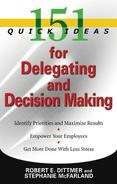

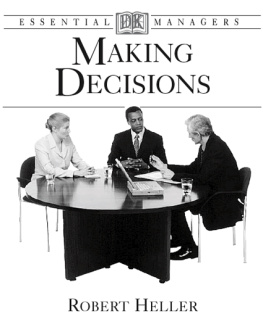
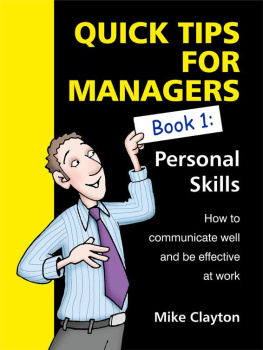

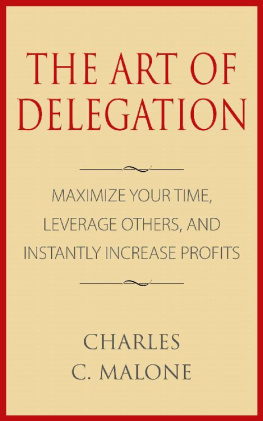

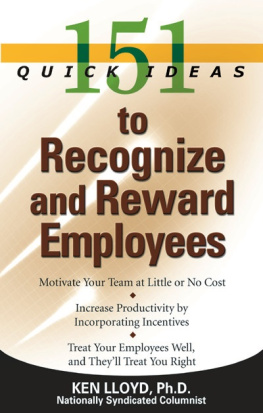
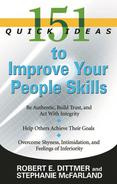
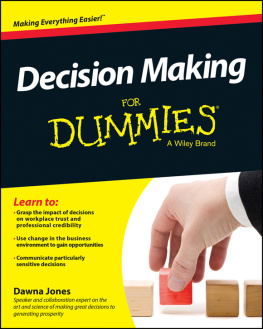


 Implement these ideas now.
Implement these ideas now.